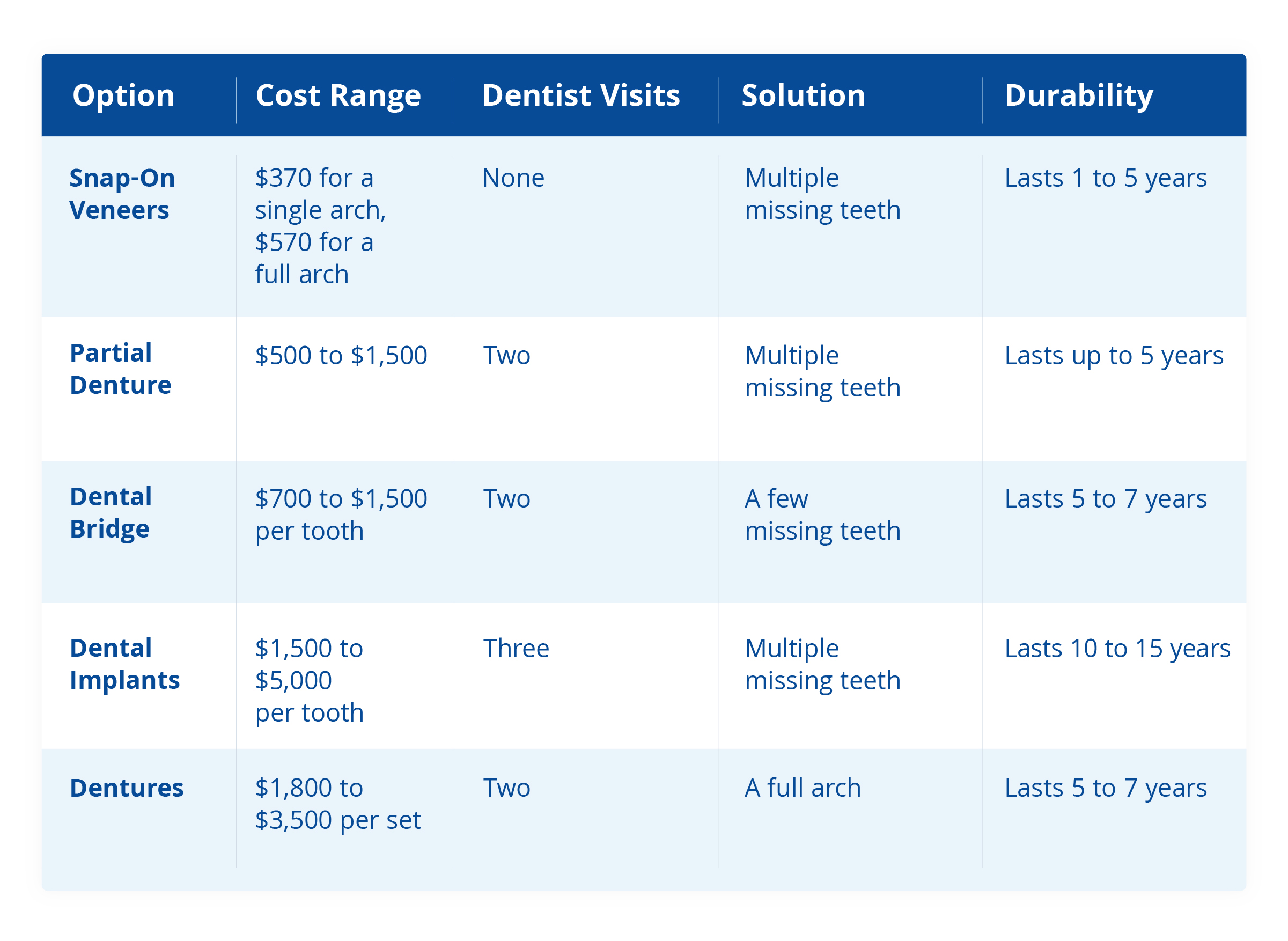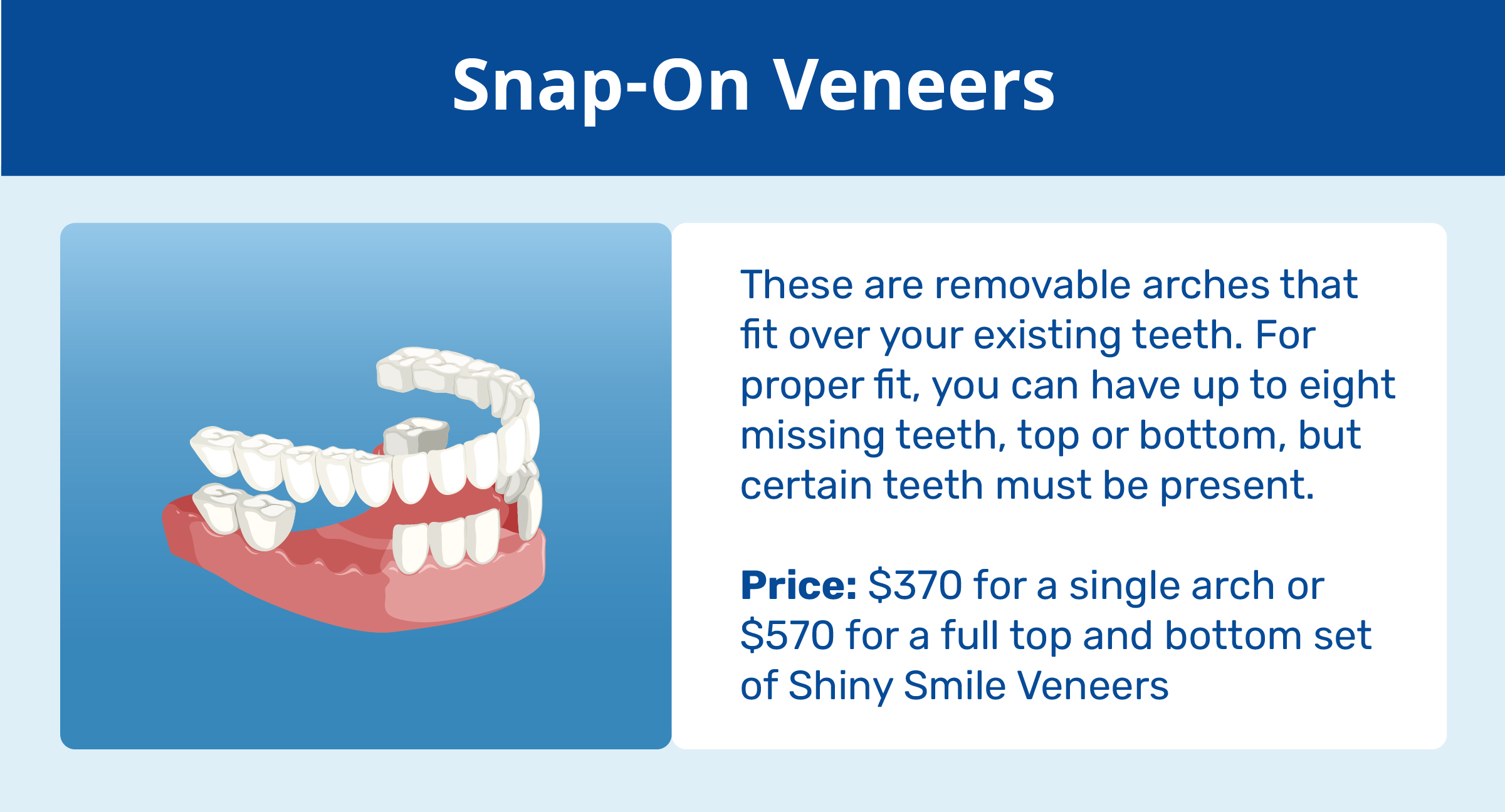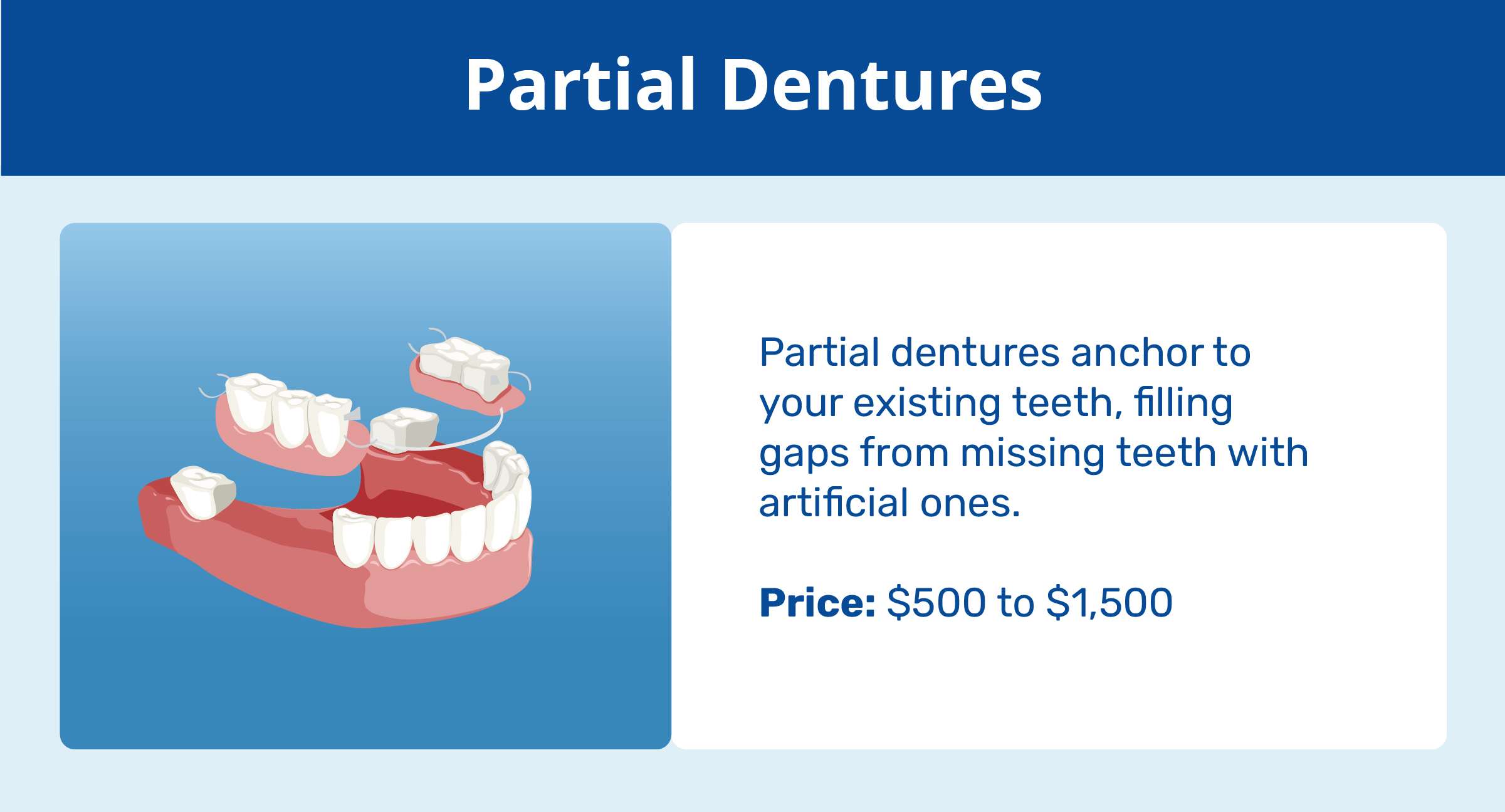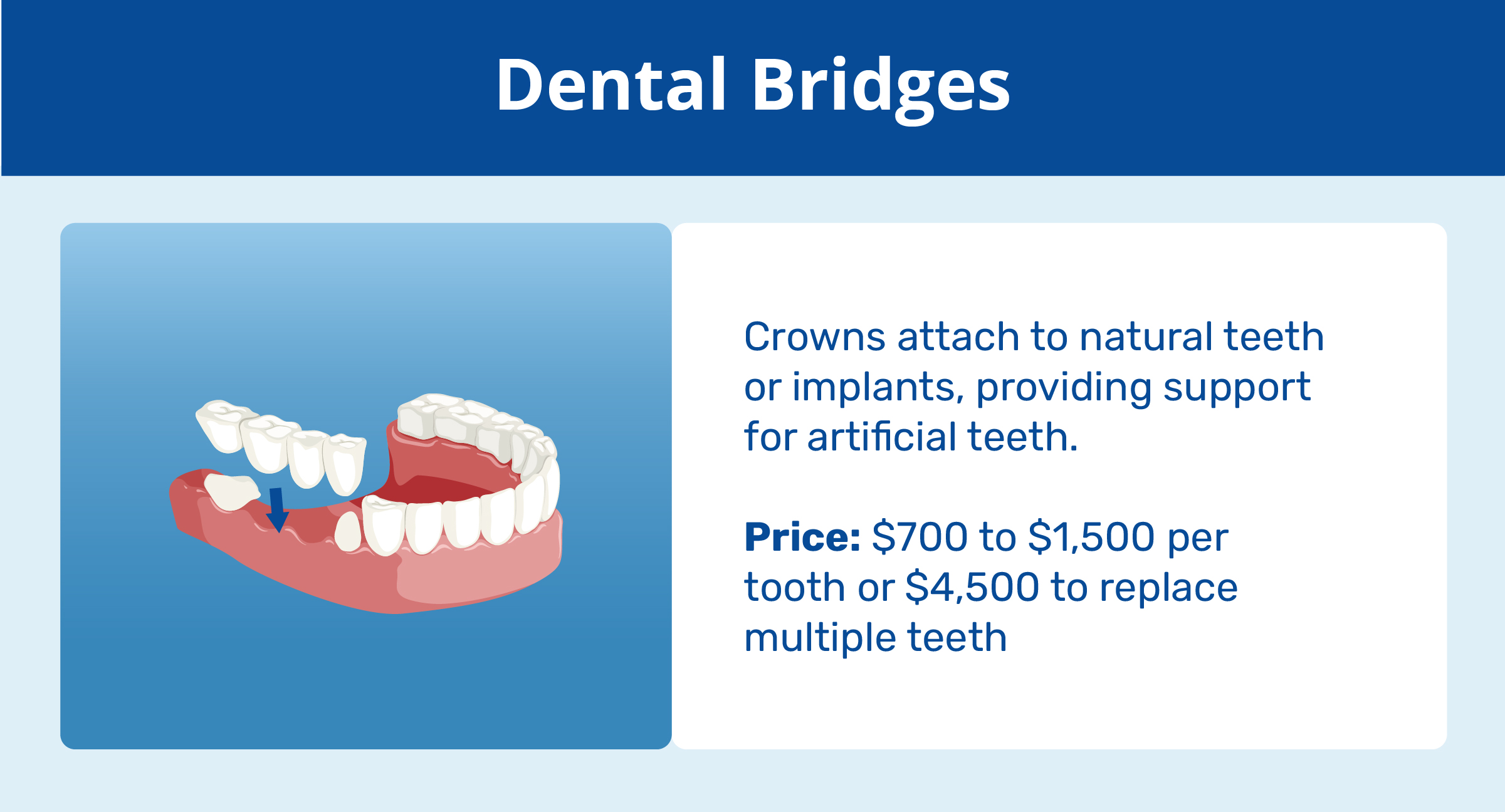

Missing teeth may make you feel self-conscious and hurt your quality of life. If you can’t spend too much money fixing missing teeth, don’t worry — there are several cost-effective options to consider.
Make sure to consult with your dentist about which treatment options are most appropriate for you. They’ll evaluate your teeth and, based on factors like your age, tooth health, and how many missing teeth you have, help you decide what to do next.
This is important because when missing teeth aren’t treated properly, they can cause issues like bite misalignment and bone loss in your jaw. The tooth replacement option you choose should help your dental health as much as it gives you your beautiful smile back.
This post covers affordable options for missing teeth, including the pros and cons, maintenance, and when you’d choose one option over another. Don’t let missing teeth hold you back — these five cheap dental replacement options will have you smiling again in no time.

1. Snap-On Veneers
Snap-on veneers are a removable arch that fits over your teeth to cover missing teeth or tooth imperfections. They can cover up to eight missing teeth on top and/or bottom but do require certain teeth to be present in order to fit.
Consider this option if you have missing teeth, slightly crooked as well as chipped or damaged teeth, or if you want to enhance your smile. It’s a cost-effective, temporary solution that makes your smile look better.
Shiny Smile Veneers, the best snap-on veneers on the market, come with a 15-month warranty and typically last one to five years. They range in cost from $370 for a single arch to $570 for a full top and bottom set.

Ordering snap-on veneers is simple:
- Receive your impression kit in the mail to make impressions of your teeth for the veneers.
- Send the kit back to Shiny Smile Veneers.
- Receive your veneers in the mail within three to five weeks.
Pros
The main pros of snap-on veneers are:
- They are the most affordable option on the list.
- You can eat soft foods while they are in place.
- No dentist appointment is required.
Cons
Some downsides of snap-on veneers are:
- You can’t eat hard or crunchy foods or drink hot liquids in these veneers.
- They are not a permanent option to missing teeth or dental health issues.
- If you have many missing teeth, they might not be a great fit.
Snap-On Veneers Maintenance
To maintain your snap-on veneers, you should remove them at night and clean them with a soft toothbrush and gentle soap. For odor elimination, soak them in dental cleaning solution for an hour and then rinse and brush them with a soft toothbrush. Avoid drying them with heat.
2. Partial Dentures
A partial denture is a removable tooth, or multiple teeth, that is either metal (the more expensive option) or plastic (the more affordable option). It clasps to your mouth by using your natural teeth as the anchor.
Removable partial dentures are a good option if you have three or more missing teeth, especially if they’re in a row. If you end up losing additional teeth, you can have teeth added to your partial denture.
Partial dentures can last up to five years, sometimes even longer, and typically cost $500 to $1,500.

The process:
- An initial dentist appointment is required to evaluate your natural teeth and see if they need to be restored to ensure their integrity and support for the dentures.
- Impressions are made to ensure the partial dentures will fit.
- At a later appointment, you’ll receive your partial dentures from the dentist and try them on.
Pros
Some advantages of partial dentures are:
- They are lightweight to wear and your remaining teeth support the dentures.
- You can eat while you are wearing them.
- Dental insurance may cover this as long as it isn’t considered cosmetic.
Cons
There are a couple downsides to partial dentures, like:
- You must remove them at night.
- If you don’t take care of your dentures or oral health, there is an increased risk for plaque, tooth decay, and gum disease.
Partial Dentures Maintenance
Remove your partial dentures every night to allow your gums and tissues to breathe. Make sure to brush your dentures or use denture cleaning tablets to soak them. Your dentist may suggest a powered toothbrush to keep plaque away.
3. Dental Bridges
A dental bridge uses your existing teeth or implants, to support artificial teeth. It not only improves your smile, but also helps you chew and use your teeth the way you could when you had a full set.
Traditional dental bridges are the most commonly used, but your dentist might suggest another type of bridge based on your specific needs.
The four main types of dental bridges are:
- Cantilever bridge: A fixed prosthetic device supported by one or more of the neighboring teeth on just one side.
- Maryland bridge: This bridge uses a metal or porcelain framework to secure a prosthetic tooth to the adjacent teeth.
- Implant-supported bridge: A bridge is anchored to dental implants in the jawbone, eliminating the need for support from surrounding teeth.
- Traditional bridge: Getting a traditional bridge involves adding a crown on either side of a missing tooth, with a pontic, or artificial tooth, in between.
A dental bridge is a good option if you have just a single tooth or two missing with healthy teeth on either side of the gap. If your teeth are completely missing, you might also need an implant to make the bridge work. Implants cost more and require recovery time.
Dental bridges typically last anywhere from five to seven years or longer with proper care. They cost about $700 to $1,500 per tooth or up to $4,500 to replace multiple teeth.

The process:
- Your dentist will prepare the abutment teeth by removing a small amount of enamel. If implants are required, they will need to be surgically placed.
- Impressions are made to create a mold, which is used to craft the bridge.
- Your dentist may place a temporary bridge.
- On your second visit, the permanent bridge is placed and bonded onto your teeth.
Pros
Some pros of dental bridges are:
- Bridges restore chewing and speaking functions.
- They prevent teeth from shifting.
- Dental insurance may cover the procedure.
Cons
Some of the cons of dental bridges include:
- They sit at the higher end of the cost range at $1,500 per tooth.
- Improper cleaning can result in plaque build up or cavities.
- You can only replace one to two missing teeth.
Dental Bridge Maintenance
Maintaining a dental bridge involves daily brushing and flossing and regular dentist check-ups and cleanings. Clean your bridge every day using floss threaders or tiny brushes that go between your teeth. Avoid chewy or hard foods or items, like pens or fingernails
4. Dental Implants
Dental implants replace the root of your tooth, meaning they’re permanently inserted into your jawbone and finished with a crown or bridge on top. Because they stay in your mouth, you don’t need to remove them at night, and they can address one or multiple missing teeth. Of all the options, they’re the most like your natural teeth.
Dental implants can last anywhere from 10 to 15 years and come at a pretty hefty price point, $1,500 to $5,000 per tooth.

The process:
- If needed, your damaged tooth is removed.
- Your jawbone is prepared for the implant which could include bone grafting if your jaw can’t naturally support the implant.
- Through a surgical procedure, the dental implant post is inserted into your jawbone.
- Your jawbone needs to heal before a fake tooth is placed.
- Several months later, once the gums and jaw have healed, the artificial tooth is placed.
Pros
The main benefits of dental implants are:
- They are a permanent solution to missing teeth and improving your appearance, chewing, and oral health.
- Your jawbone health improves because the implant roots promote jawbone growth.
Cons
Some potential downsides of dental implants are:
- It requires a lengthy procedure and months of healing.
- Implants are more expensive than other options.
- If you have a weak jawbone, implants may not be a viable option.
Dental Implant Maintenance
To maintain dental implants, make sure to use a soft-bristled toothbrush and implant-specific toothpaste. Rinse your mouth between meals using an antiseptic mouthwash meant for implants.
5. Dentures
Full dentures are similar to partial dentures, except that they’re used to replace a full mouth of teeth. If most of your teeth are missing, you may choose to get the remaining teeth extracted so that you can use this option.
Traditional dentures stay in place with adhesive. Implant-supported dentures are a sturdier, semi-permanent option, though the procedure is more invasive and expensive. In general, dentures are a great option if you’re missing all or almost all of your teeth, upper and/or lower.
Dentures last anywhere from five to seven years, and cost about $1,800 to $3,500 per set.

The process for traditional dentures:
- You’ll have an initial consultation with your dentist to decide next steps.
- Your dentist will extract any teeth as necessary.
- Once healed from the extraction, your dentist will make a dental mold for your dentures.
- The dental technician will build your dentures based on the mold and polish them.
- Your dentist will have you try out the dentures to make sure they work.
Pros
Some pros of dentures are:
- You’ll have a better and easier time chewing compared to missing teeth.
- Your smile will look improved.
- You’ll have better speaking abilities than you would with missing teeth.
Cons
Here are some of the potential downsides:
- Dentures can shift, slip, or wobble when you eat or talk making them difficult to use regularly.
- Your jawbone shrinks because you don’t have teeth to stimulate bone growth.
- Dentures can be expensive unless dental insurance covers it.
Dentures Maintenance
Remove every night to give your gums and tissue air and allow for circulation. Clean your mouth after removing your dentures using a soft-bristled toothbrush. Make sure to brush your dentures daily to keep them clean. Then soak them overnight in water or a denture solution, rinsing them before putting them back in your mouth.
Covering Dental Costs
If you’re short on cash, some dentists offer monthly payment plans for dental implants or other restorative treatments without interest — you may just need to meet the minimum monthly payment to qualify. Similarly, you may be able to ask your dentist for a discount by agreeing to see them biannually or referring other patients.
You can also try shopping around for dentists in your area to find the best solution and most supportive practice for your needs. It never hurts to ask for help.
Ready to Smile Again?
It’s hard to feel confident when you’re self-conscious about your smile. But missing teeth don’t have to hold you back. Trying an affordable tooth replacement option can restore your smile without overextending your budget.
For a safe, effective, and cost-conscious solution, try Shiny Smile Veneers. A set of top and bottom veneers only costs $570. Plus, our custom veneer process covers all your needs without a visit to the dental office. Order your home kit today, and take one step closer to the brighter, whiter, beautiful smile you deserve.
